Leoš Janáček's ebullient Nursery Rhymes [Řikadla] (1925-27) occupy a unique position in the composer's output. Although they are among his very last works (followed only by From the House of the Dead and the Second String Quartet), the Nursery Rhymes are imbued with a simplicity and lucidity befitting their subject matter that render them among his most witty musical offerings. Oddly, they are also among the least discussed and researched of his works. In his eighteen Nursery Rhymes, Janáček laid bare his most fundamental compositional techniques, concomitantly making them an ideal introduction to his style. The present study begins with the examination of several characteristics of his neotonal style as they occur in three of the Nursery Rhymes. These features are: mixed meter and polymetric subdivisions, stratified textures, diverse scale resources, motivic construction, the avoidance of authentic cadences, pandiatonicism, prevalent chord types, key area biases, tonal non-concentricity, and text-painting. We will examine two songs in their entirety, "The White Goat is Picking Pears" and "Frankie Plays the Bass," nos. 14 and 7 respectively, and conclude by looking at the ways in which the first nursery rhyme, "The Turnip's Wedding" (numbered as 2, since the instrumental introduction is number 1) serves fleetingly as an exposition of the raw materials on which the cycle is based.
Stylistic Evolution
Janáček's compositional style changed and developed in stages throughout much of his life. His early Romantic style of the 1870s and early 1880s was influenced equally by Dvořák and Wagner. In 1888, the ethnographer František Bartoš asked Janáček to accompany him on a trip to the composer's native region of Valachia in Eastern Moravia in order to help him notate the folksongs of that region. Janáček was deeply moved as he listened to and notated the music, much of which was familiar to him from his childhood. Together, Bartoš and Janáček collected and published over 2,200 folksongs in three volumes in the next twelve years.1 In fact, in the last decade of the nineteenth century, Janáček did more collecting and arranging than composing. Moreover, he borrowed melodies directly from folk music for use in his own music which he composed between the years 1888 and 1894. These works include the Lachian Dances, the ballet Rákos Rákoczy and the unsuccessful opera The Beginning of a Romance.
Janáček's "folk stage" of composition was essential to the development of his mature style. The fact that he studied Moravian folk music, rather than Bohemian, was equally crucial. The two types of music have disparate histories and therefore are stylistically distinct from one another. The folk music of Bohemia has much in common with German and Austrian folk music, being mostly in major or minor tonalities, in a standard meter (often of a dance character) and sometimes containing elementary syncopation. The folk music of Moravia is rooted in diverse sources such as ancient chant, old Slavonic modes, and the rhythms of old Moravian and Slovakian dance music (some of which are akin to those of Hungary).2 In addition, the hilly landscape of Moravia isolated some musical styles within regions, further increasing the number of traits of Moravian music. A Moravian folksong may be in any of dozens of diverse scales and modes.3 The rhythm of the slower songs tends to be free and rhapsodic, following both the natural rhythm of the text and the character of the emotion expressed therein. Dance rhythms may have strong cross accents, or even mixed meter. Often the second and fourth beat in a simple quadruple meter are slightly prolonged by the performers, giving the effect of an irregular meter. Some Moravian folksongs even begin and end in different, non-relative keys.4
Indeed, Moravian folk music possessed a wealth of musical ideas which Janáček drew upon as he purposefully renounced the German Romantic tradition. However, Janáček's most characteristic and personal musical style began to emerge in 1894, at the point when he ceased to borrow from folk music, but instead began to transform the rich elements of folk music into a new and considerably progressive idiom.5 (He did, however, continue to transcribe, arrange and publish folk music of Moravia and Slovakia throughout the rest of his life, and also wrote more than seventy articles and feuilletons concerning numerous aspects of the nature of folk music.) Works which first evidence this change include the cantata Amarus (1897) and the opera Jenůfa (1894-1903). Janáček's style continued to evolve; historians usually place the beginning of his last and most characteristic compositional phase around 1916.6 It was in this year that the sixty-two year old composer achieved his first critical acclaim through the successful Prague premiere of Jenůfa. In these highly prolific last twelve years of the composer's life, he composed the majority of his most acclaimed pieces, beginning with works such as Taras Bulba (1915-18) and The Diary of One Who Vanished (1917-19), and ending with the Nursery Rhymes (1925-27), From the House of the Dead (1927-28), and the Second String Quartet (1928).
The Nursery Rhymes were inspired by the weekly children's page of the Brno newspaper, Lidové noviny, which featured anonymous nonsense rhymes and accompanying whimsical illustrations by Czech artists Josef Lada, Ondrej Sekora and Rudolf Hála. (for examples, see Illustrations 1-3). Janáček began the work during his summer holidays in 1925 as a collection of eight songs for three women's voices, clarinet and piano. Late in the following year he expanded the work to include an instrumental introduction followed by a total of eighteen songs and a postlude. He employed an expanded ensemble, scoring the rhymes for nine voices, a mixed wind ensemble, double bass, piano, ocarina and toy drum. He completed the cycle in January 1927. Most of the texts of the nursery rhymes are in Czech, although three are in a Moravian dialect of Czech (nos. 11, 16 and 18), one is in Slovak (no. 12) and the final one is in Ukrainian. The outcome is a singular work whose freshness and giddy humor belie the composer's seventy-two years as well as his painstaking labor to perfect its final version.
Illustration No. 1: "The White Goat is Picking Pears," by Josef Lada
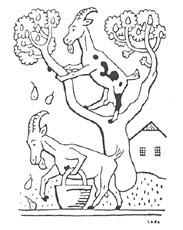
Example No. 1: "The White Goat is Picking Pears"
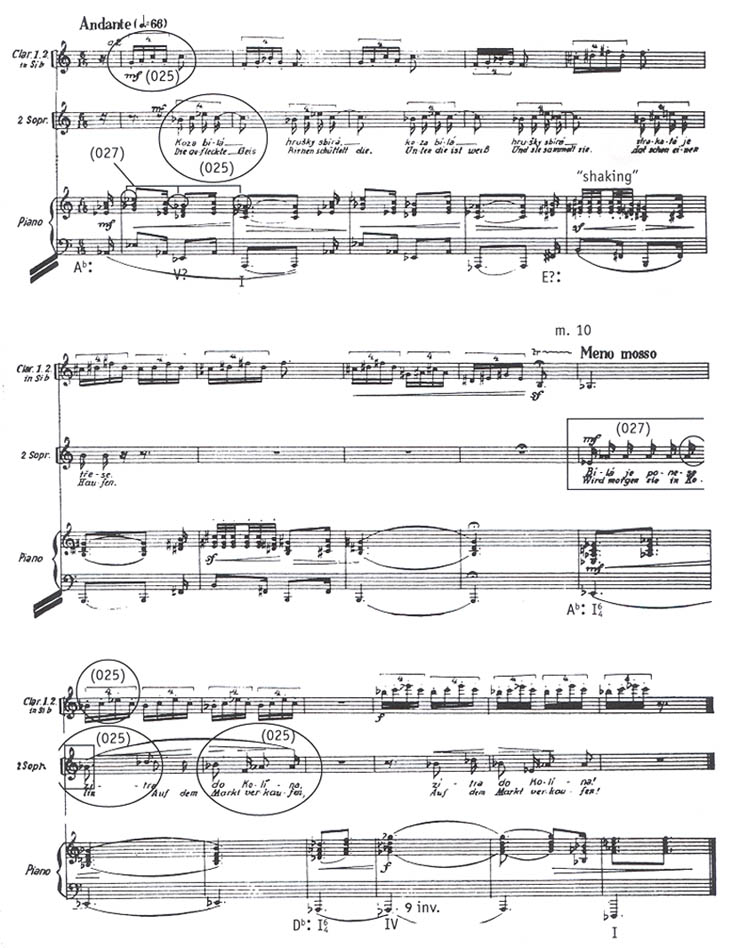
"The White Goat is Picking Pears"
The sixth song of the original set, "The White Goat is Picking Pears" [Koza bílá hrušky sbírá] became no. 14 of the final set (Ex. 1). Janáček was evidently satisfied with the original version of this song,7 since the only changes he made when he revised and expanded the work in 1926-7 were to double the clarinets and to add more dynamic indications. The number of Janáček's signature traits concentrated in the sixteen measures of this song is remarkable. A literal translation of the text follows.
The white goat is picking pears
The spotted goat shakes them down
The white one will carry them
To Kolín town tomorrow.
Mixed Metric Subdivisions and Stratified Texture (measures 1-4)
Since the meter and its division are, both aurally and visually, the most striking characteristics of the song's opening, we will begin with a discussion of these features. The quartuplets in the sopranos and clarinets are in a simple division of the meter which is superimposed over the compound division in the piano. In both theory and practice, Janáček exhibited his fascination with the sequential alternating of different rhythmical subdivisions, as well as with the simultaneous subdivision of simple and compound meter. He quipped: "Measure a piece in a single meter? That is a theory; measuring in various meters is more authentic."8 The various possible simultaneous divisions of meter and beat play a significant role in Janáček's own theories of melody, harmony and affect.9 Although mixed divisions were common to the Romantic style, Janáček's predilection towards their prominent layered application in his own compositions was undoubtedly influenced by their occurrence in the Moravian folk music that he collected and transcribed.10 For example, Janáček's transcription of a Moravian folksong as accompanied by the cimbalom (see Ex. 2) exposes distinct layers of simple and compound rhythmic divisions.
Example No. 2: Folksong from Polanka: "The Girl Pulled Up the Grass"
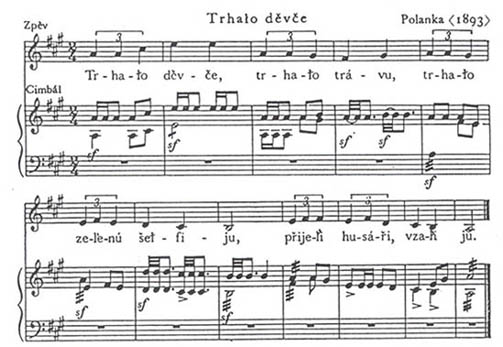
The metric interest of "The White Goat" is enhanced by the imitation between the clarinets and voices. In addition, the piano's motive inflects metrically towards the downbeats of the second and fourth measures. The combination of this inflection, the polymeter, and the alternating imitations makes the downbeats difficult to perceive and creates a buoyant ambiance. There is no strong downbeat until m. 10, at the tempo change.
The texture of the song is engendered in the sequencing of short motives which are then layered in stratification. Janáček stacks motives and strings of motives on top of one other to build both texture and harmony. This characteristic static layering is similar to that seen in Debussy's and Stravinsky's work of the 1910s. Christopher Salocks explains this prevalent strata technique:
Strata refers to the easily separable musical layers, which might almost be described as contrapuntal, were it not for the clear but momentary subordination of one part to the other. A subordinate figure may suddenly arise to the most prominent melodic position, and vice-versa. The difference between the "strata" of Janáček's music and the "parts" of other music lies in the essentially static nature of Janáček's material. They are often ostinato-like, with no sense of large-scale harmonic movement.11
Example No. 3: The Fiddler's Child, mm. 452-57
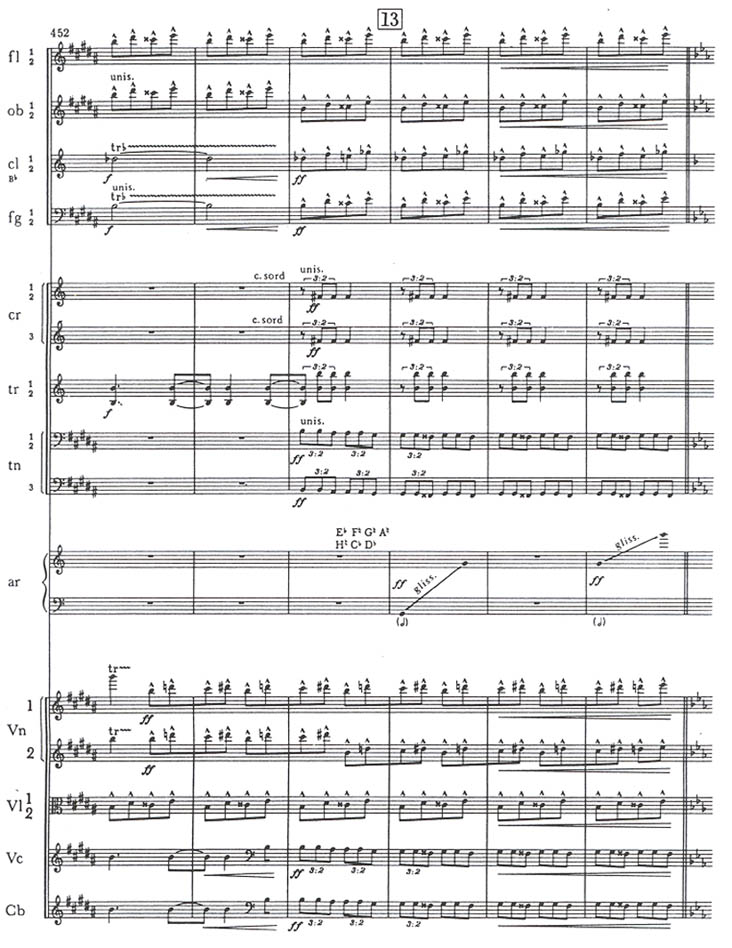
Examples 2 and 3 demonstrate the layering of textural strata in two of Janáček's orchestral works. The excerpt from The Fiddler's Child (Ex. 3) contains four distinct layers: the winds and higher strings contain an eighth-note ostinato; the trombones and lower strings contain a repeated triplet figure; the horns and trumpets have the single note B within yet a different rhythmic figure; the harp has two glissandos. In addition to its stratified layers, example 4 from Taras Bulba contains a quick alternation between motives in the violins and violas.
Example No. 4: Taras Bulba II, mm. 56-58
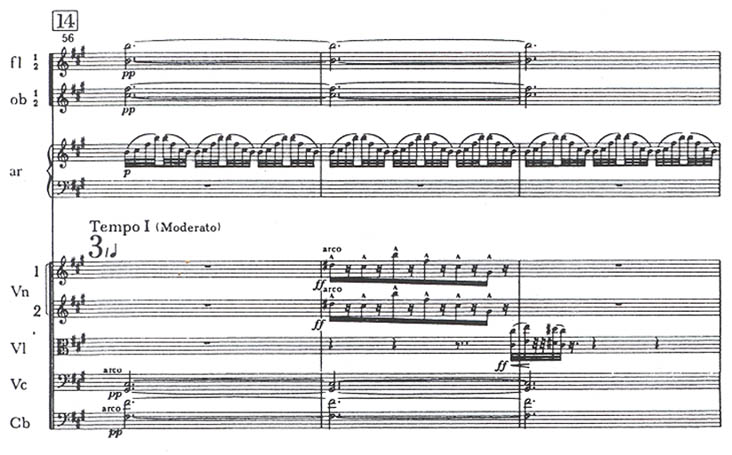
Sčasovky Motives, Pitch-class Sets and Pentatonicism (measures 1-4)
"The White Goat" begins with a six-note motive in the piano and a four-note motive which alternates between the sopranos and clarinets. Janáček referred to his typically curt motives as "sčasovky" (singular, sčasovka), a word which he coined for melodic or rhythmic or melodic/rhythmic entities that occur in a very short unit of time.12 Difficult, if not impossible to translate into English, Michael Beckerman's coined term "entimelet" is perhaps as close as one can come.13 Sčasovky became the fibers with which Janáček wove both melody and texture in his music. In "The White Goat," the four-note motive alternates in a dialogue from the clarinets to the voices, while being supported by repetitions of the six-note motive in the piano. Sčasovky may thus layer on top of one another to form diverse textures varying from a simple melody with accompaniment (as in "The White Goat") to stratified layers of relatively equal interest (as in Ex. 4) to walls of energized sound (as in Ex. 3). Janáček's sčasovky tend be similar in rhythm and melodic contour to the short speech-melody motives which he noted of the speech of both friends and strangers throughout much of his life.14
The interval content of the four-note motive in the clarinets and voices in "The White Goat" is especially characteristic of a sčasovka. It contains three original pitch classes whose sequential intervals comprise a major second followed in the same direction by a minor third. This intervalic combination and its inversion (a minor third followed in the same direction by a major second) are among the most common small configurations in Janáček's oeuvre.15 This collection occurs in various motivic guises throughout the first third and last third of the Nursery Rhymes. Because Janáček freely transposes these self-contained motives to different pitch levels while retaining their original intervalic content, it is helpful to apply nomenclature from set theory to describe them. Thus, the prime form of the motive in the clarinets and voices is [025].16
At the song's opening, the [025] motive occurs at three different pitch levels. The combination of two sets at a time forms two different anhemitonic pentatonic collections. In the first measure this collection is a pentatonic collection (Bb-C-Eb-F-G);17 in the third measure, the collection is (Eb-F-Ab-Bb-C). Due to the melodic contour and metric stress, every other note is accented (i.e., F, Bb and Eb), emphasizing the quartal aspects of the pentatonic collection. When this pitch-class set is re-arranged into its smallest possible range, its normal order is revealed as Eb-F-Bb: a major second followed by a perfect fourth. Next to [025], this [027] set is the most common motivic trichord in all of Janáček's music. Although it is presented here only in an outlined form, the set [027] is featured prominently and melodically in Nursery Rhymes numbers 2, 3, 4 and 18. Motives which are based on the [025] and [027] sets are also common to Moravian and Slovak folk music and saturate other works by Janáček, such as the opera The Cunning Little Vixen (1921-23), the Sinfonietta (1926), and the Glagolitic Mass (1926).18
Cadential Avoidance and Pandiatonicism (measures 1-9)
The lack of authentic cadences in "The White Goat" is characteristic of Janáček's style. Like Debussy, Janáček fashioned ways harmonically to bring about phrase closure, as well as to determine tonal centers, without retreating to what Debussy referred to as the "embrace of the old lady": the authentic cadence.19 Janáček employed extended and altered dominant sonorities common to the nineteenth century, but he developed other means of harmonic closure which merely emulated or hinted at the authentic cadence. One such means is encountered early in the course of "The White Goat." Despite the melodic pentatonicism established around keynotes B-flat and E-flat, the chords and bass line of the piano determine the opening key area of the song to be A-flat major. The authentic cadence in the piano between mm. 1 and 2 is not only unsupported by the other parts, but it is interrupted by a I7 that acts as an escape chord over an anticipatory bass. The same figure occurs in mm. 3, 5, and 7. There are no traditional authentic cadences in this song, and very few in Nursery Rhymes as a whole.
After a direct modulation in m. 5, the tonal center becomes more obscure. The voices, clarinet parts and the bass of the piano seem to indicate the new key to be E major. Although the notes are diatonic to E major, the harmonies (including ninth and seventh chords) do not conform to any standard chord progression. Instead, the chords that prevail are C-sharp minor and G-sharp minor triads. (If the left hand of the piano were omitted, the key area might be perceived as B major.) Such neotonal pandiatonicism often occurs in Janáček's music alongside standard major and minor tonality, modality, pentatonicism and synthetic scales.
Distinctive Harmonies: Second-Inversion Triads and
Inverted Ninth Chords (measures 10-16)
With the changes in tempo and texture in m. 10 comes a significant change in mood. More sustained than before, the singers' melody is in a compound meter and uses the notes of the A-flat anhemitonic pentatonic scale. The melody contains several [027] and [025] cells within its contour, including the Ab-Bb-Eb [025] set that it shares with the clarinets.
The harmonies within the sustained chords of the piano during the last seven measures are especially distinctive of the composer's style. At m. 10, a return to the tonal center A-flat is suggested by the E-flat pedal, over which a second inversion A-flat major chord and a subsequent B-flat minor chord suggest a pedal cadential six-four chord followed by a supertonic chord over a dominant pedal. (This second sonority occurred already as the third chord of the first measure of the song.) No resolution follows, either to a root position dominant chord or a tonic chord. Instead, a D-flat major chord ensues, also in second inversion. Janáček's emancipated and frequent use of second inversion triads are a characteristic of his style that he developed quite early. Indeed, Janáček believed that the harmonic interval of a fourth was completely consonant, more so than the harmonic third, and that it required no resolution!20 The third and fourth Nursery Rhymes even end on a second inversion triad.
After the phrase (or "direct") modulation to the key of D-flat in m. 13, a distinctive chord is heard (m. 14) as the first and only forte harmony in the song. This G-flat major chord superimposed over an A-flat bass (m. 14) carries with it both dominant and subdominant function. Although the chord could be considered as a dominant eleventh chord with the third and fifth omitted, the subdominant import of the chord is more substantial. Therefore, this chord is better understood as an inverted subdominant ninth chord (the ninth is in the bass).21 Inverted ninth chords on various scale degrees feature prominently in most of Janáček's mature works. In Example 5 from The Cunning Little Vixen, two such chords appear adjacently in a non-diatonic context. In "The White Goat," this chord becomes another technique by which Janáček hints at, yet evades, the authentic cadence. The free use of second inversion triads and inverted ninth chords make the harmony of the last seven measures of the song evocative of a number of Janáček's works, including the violin sonata (1913-21) and the opera Káťá Kabanová (1919-21).
Example No. 5: The Cunning Little Vixen, Act. 3
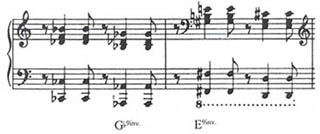
Key Bias and Tonal Non-Concentricity
Two final characteristics of Janáček's style that we will examine concern keys and tonality. The key of A-flat (in various modes with either a major or minor third degree) is the principal tonic of Nursery Rhymes as a whole. Fourteen of the songs either begin or end in a mode of A-flat, although, of these only four both begin and end in A-flat. By far the two most frequent key centers in Janáček's music are A-flat and D-flat, used in both major and minor modes as well as in other modes and modal combinations.22 In addition, the majority of Janáček's mature works do not begin and end in the same key, and therefore are considered to be tonally progressive. Accordingly, A-flat and D-flat also represent the most common key centers of Janáček's tonally progressive works and movements. "The White Goat" begins in A-flat major and ends in D-flat major, as do Nursery Rhymes nos. 5 and 9, and also "The Madonna of Frydek," from the piano cycle On an Overgrown Path (1901). Works or movements which begin in either A-flat major or minor and end in either D-flat major or minor are numerous, including the eighth Nursery Rhyme, the third act of the opera Fate (1903-4), the final movement of the piano suite In the Mists (1912), the second movement of the oratorio The Eternal Gospel (1914), the symphonic poem The Ballad of Blaník (1919-20), the whole of The Cunning Little Vixen (as well as its third act), the second movement of the Sinfonietta (1926), and the final movement of the Second String Quartet (1928).
The motion between the first and last keys in all of these tonally progressive works is down by a perfect fifth. The reverse motion, up a perfect fifth, is also common; pieces which begin in a mode of D-flat and end in a mode of A-flat include the first song of The Diary of One Who Vanished, the third movement of the wind sextet Youth (1924), the final movement of the Concertino (1926), and the third movement of the Second String Quartet. Progressive tonality can be found in Janáček's music at every interval level. In Nursery Rhymes the next most common outer-key motion (after down by a perfect fifth) is down by a major third, as in Nursery Rhymes no. 1 and no. 7 (from A-flat minor to the chromatic mediant key of F-flat major, spelled as E major), no. 5 (from D-flat Major to C-flat Major, spelled as B major) and the final song, no. 19, (from D-flat minor to B-double flat major, spelled A major). Other motions exhibited in Nursery Rhymes are up a major second (no. 15 and no. 16), up a minor third (no. 4), down a minor third (no. 13), and up (or down) by a tritone (no. 11). A possible derivation for this tendency is found again in Moravian folksongs, a small number of which end in a different key, especially in the key of the supertonic, subdominant or dominant.23
Text-Painting
Before we leave "The White Goat," we should note the composer's skill in creating aural impressions that reflect that text. A lover of nature, Janáček enjoyed emulating the sounds of nature in his music. Among his most famous offerings of this type are the storm in the second act of Káťá Kabanová and the animal sounds throughout The Cunning Little Vixen. Although he spares us the bleating of goats in Nursery Rhymes, he depicts the rustling of pear branches as they are shaken down by the spotted goat in the thirty-second-note chords of the pianist's right hand (m. 5). This motive is derived from the piano's original motive (m. 1). The impression of moving foliage is also captured in Janáček's piano miniature "A Blown-Away Leaf," no. 2 from the first book of On an Overgrown Path.
Illustration No. 2: "Frankie Plays the Bass" by Josef Lada
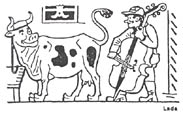
"Frankie Plays the Bass"
Like "The White Goat," the seventh nursery rhyme, "Frankie Plays the Bass" [Fránta rasů hral na basu] (Ex. 6) was one of the original eight rhymes Janáček set in 1925. In his 1926 revision, he gave the melody to three tenor voices and added the string bass, befitting the text:
Frankie, the knacker's son, played the bass
By the old cow's tail.
The old cow was glad
To have Frankie for a pal.
Example No. 6: "Frankie Plays the Bass"
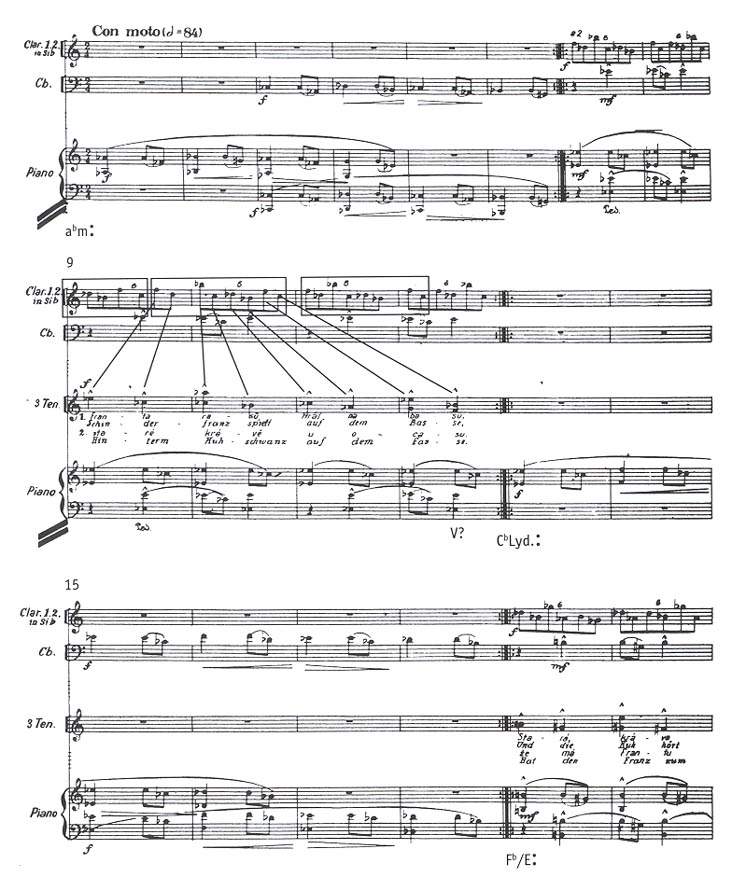

Several similarities between the musical processes of "The White Goat" and "Frankie" are readily discerned. The texture is again built by the sequencing and layering of static motives. The canonic imitation between the two hands of the pianist in "Frankie" is akin to the imitation between clarinets and voices at the beginning of "The White Goat." (Janáček employs similar canons in the fanfares that begin both the Sinfonietta and the Glagolitic Mass, creating layered polyphony which is not, strictly speaking, contrapuntal.24) Both songs feature the simultaneous combination of simple and compound divisions; however, the rhythmic processes of "Frankie" are more complex. The ostinato motive in the clarinets beginning at m. 7 is eight notes in length. Since the pattern is too long to fit into one measure of sextuplet eighth notes, it spills over into the next measure, creating a pattern that does not align with the meter. The clarinet ostinato is comical not only because of its rapidity and jaggedness, but because it creates a rather wild polymetric pattern. The first note of the ostinato pattern does not align again with a downbeat until m. 11. The motive is actually a diminution of the voice part at m. 9, where it neatly fits the trochaic tetrameter of the text. Janáček subverts the squareness of the vocal motive by combining it with itself (in the clarinets) at three times the speed.
The tonality of "Frankie" is progressive, beginning in A-flat harmonic minor and ending in the related key F-flat Lydian (re-spelled as E Lydian in the piano and bass). This motion is mediated in mm. 13-18 by a passage in C-flat Lydian. The Lydian mode (indigenous to the folk music of Moravia and Slovakia) is employed also in rhymes nos. 6, 11 and 13. In m. 19, the layered motive of eight notes returns but is transformed to conform to the familiar anhemitonic pentatonic mode until the end of the song.
An aspect of "Frankie" that distinguishes it from "The White Goat" is its lack of triadic harmony. The harmony which does exist is the incidental result of the layering of motives. It is largely static but contains implications of traditional dominant and tonic progressions. Measures 1- 12 create the overall impression of A-flat minor, but with concentration on the second scale degree. An E-flat dominant harmony is suggested in m. 12 when the lower tenor sings a G-natural; yet this note is superimposed over a static harmony in the other musical layers. A B dominant-ninth chord beginning in m. 23 results from the layering of motives. Unlike the E-flat dominant harmony, this chord resolves functionally (m. 27). However, Janáček "buffers" the resolution by flavoring the last six measures in E Lydian with the implications of G-sharp minor (equivalent to the original key of A-flat minor); the F double-sharps in the piano act as local leading tones to the note G-sharp.
The ending is humorous. The F double-sharps long thwart the effect of complete resolution into the key of E Lydian while yielding the added effect of a split third. The low E finally shows up in the bass line to end the song, yet it occurs on a weak beat. The piece ends surprisingly on the F double-sharp, as though the obstinate note realized too late that the song was over!
Illustration No. 3: "The Turnip's Wedding" by Ondrej Sekora
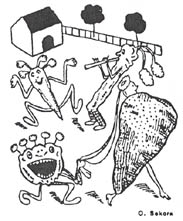
"The Turnip's Wedding": An Embryonic Introduction
The first song of the final version of Nursery Rhymes is "The Turnip's Wedding" [Řípa se vdávala]. Since Janáček composed the instrumental introduction and postlude after completing the set of songs, it is likely that he originally intended "The Turnip's Wedding" itself to be the very first number of the set.25 Both the instrumental introduction and "The Turnip's Wedding" present motives, scales and techniques that are used and developed later in the work. We will examine the first ten measures of the latter for their seminal properties, i.e., the ways in which they introduce raw materials which are developed in the cycle (Ex. 7). The investigation serves at the same time as a review of the techniques we have examined.
Example No. 7: "The Turnip's Wedding," mm. 1-10
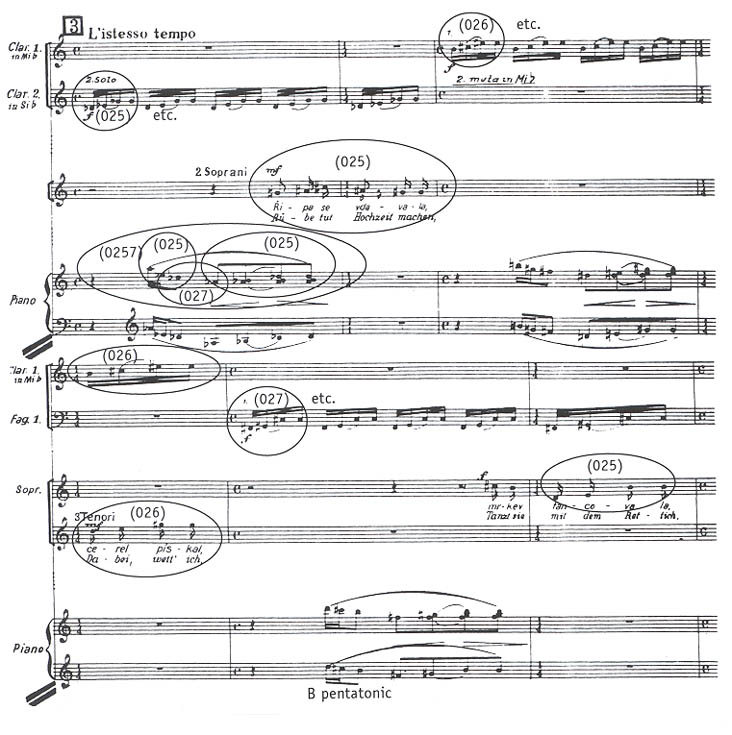
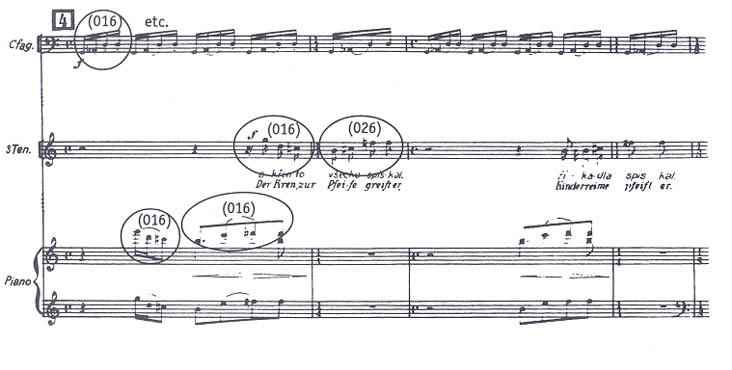
The complete text of "The Turnip's Wedding" is sung within in the first ten measures of the song:
The turnip got married
The celery piped
The carrot danced,
and the horseradish arranged it all
He caused the rhymes.
Tidli, tidli. . . Tidli, fidli . . Tidli, dudli . . .
The fifth line, "He caused the rhymes," was added by Janáček for the purpose of making this first rhyme to serve as a prologue to the rest; i.e., not only did the horseradish make the wedding arrangements, but he was responsible for the rhymes to follow. The ensuing nonsense words "tidli, fidli" and "tidli, dudli," also added by the composer, comprise the bulk of the song and represent respectively the sound of fiddles and bagpipes at the wedding party. The ten measures of music set to the nursery rhyme text are protean and inconclusive. They act locally as an introduction to the 64 measures of nonsense words that follow; they serve generally and more significantly as an embryo of the rest of the cycle, presenting the principal cells, pitch collections and textures which follow in the subsequent songs.
The mixed meter of "The Turnip's Wedding" is an extension of the meter of the instrumental introduction (Ex. 8), where two measures of 2/4 alternate with one measure of 1/4, and sound as a quintuple meter. At the beginning of "The Turnip's Wedding," the meter alternates between 4/4 and 1/4; however, the overlapping of motives combine with the irregular entrances of the voice segments to confuse the listener's perception of the meter. The down-beats of the song are even more difficult to discern than those of "The White Goat."
Example No. 8: Nursery Rhymes, Introduction, mm. 1-6 in reduction
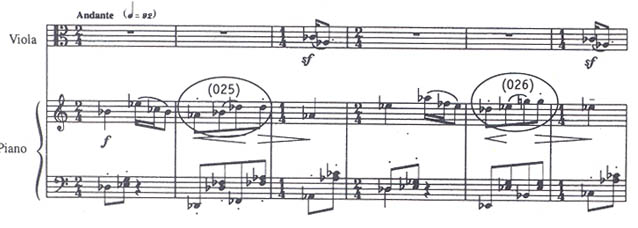
Just as the downbeats and meter of "The Turnip's Wedding" are obscure, so is its key center. This is largely because the motives in various voices do not combine to form diatonic collections. The vocal line, in fact, contains a complete octatonic collection, which is completed at the point in which the original text ends, i.e., at the F-natural in m. 8 where the tenors first sing "spískal," meaning "caused." The pitch classes in the winds belong to this same collection as well. Other examples of his use of octatonicism can be found in the Sinfonietta and in The Ballad of Blaník. Janáček demonstrated even more interest for another symmetrical scale: the whole-tone collection. It occurs in the vocal lines of Nursery Rhymes 10 and 15 and is used substantially in many works, most notably in Káťá Kabanová, The Cunning Little Vixen, Youth and the Concertino.
"The Turnip's Wedding" begins with three sčasovka motives layered in the clarinets, the piano and the sopranos. Within these motives, Janáček presents the most important small pitch sets which he employs and develops later in the cycle. All motives in the first two measures are based on the [025] set. The non-octatonic set in the piano [0257] is the union of two [025] sets and contains the other seminal set [027] as well. As in "The White Goat," Janáček emphasizes the quartal attributes of the anhemitonic pentatonic collection, this time in the piano.
The motives of "The Turnip's Wedding" develop through set expansion. In the third measure, the [025] set expands to the whole-tone set [026]. In this manner, the motives of the first clarinet and piano hint at the Lydian and whole-tone tonalities that are to come. In m. 5, the motive expands to the [027] motive. Where can the set go from [027]? To expand to [028] would result in the inversional equivalent of [026]. Instead of expanding, Janáček contracts the set to [016] in m. 7, first in the piano, then imitated in the tenors. The same set is transposed and inverted in the contrabassoon and piano in the second half of the measure. This collection of three [016] sets in m. 7 is the most dissonant measure of the ten-measure rhyme. In the following measure the octatonic aggregate is formed in the voice part at the point where the motive returns to the more consonant set [026].
The remainder of the song (not provided) introduces more of the techniques and characteristics seen in "The White Goat" and "Frankie." Its tonal centers are A-flat minor and F-flat/E major. It combines triads in the pianist's right hand (as in "The White Goat") with incidental harmonies formed by layers in the left hand, voices, and winds (as in both "The White Goat" and "Frankie"). Its harmonies are largely static, similar to those of "Frankie." The dominant harmony is often altered: at rehearsal no. 6 the dominant chord contains a flat ninth; and at rehearsal no. 7, it is contains an augmented fifth. The prominent rhythmic characteristics of the rest of the song are the syncopated ostinato layers within a mixed meter. The texture and rhythm of the song become increasingly more complex; at m. 59, Janáček changes the clarinets' ostinato to 16th-note triplets, providing a mixture of compound and simple divisions similar to that of "Frankie."
Conclusion
The principal purpose of this article has been to recognize the ways in which Nursery Rhymes demonstrate a synthesis of Janáček's compositional style. The fact that Janáček composed a work at the end of his life that contains an abundance of his signature traits is trivial. What is remarkable, however, is how Janáček imbued each of these miniature compositions with keen organization, wit and perfection by employing the same compositional principles and techniques of his larger works. For this reason, Nursery Rhymes bears a kinship to Béla Bartók's celebrated six-volume piano cycle Mikrokosmos (1935). Unlike Mikrokosmos, Nursery Rhymes is not pedagogical work. In fact, it was not intended to be played or sung by children at all; on the contrary, it was inspired by rhymes, rhythms and illustrations from the play-world of children.26 Nevertheless, both works disclose the essence of their creator's mature art within relatively elementary models that may be readily understood and enjoyed.
1Kytice z národních písní moravskvých [A Bouquet of Moravian Folk Songs] Telč: Šolc, 1892; Národní písně moravské v nové nasbírané [Folk songs of Moravia Newly Collected], Prague: Česká akademie, 1899 (Vol. 1), 1901 (Vol. 2).
2Jiří Vysloužil, "Janáčkova tvorba ve světle jeho hudebně folkloristické teorie" [Janáček's Works in Light of his Theory of Musical Folklore], Leoš Janáček a soudobá hudba (Prague: Knižnce hudebních rozhledů, 1963), 365.
3Adelheid Geck, Das Volkslied Material Leoš Janáčeks: Analysen der Strukturen unter Einbeziehung von Janáčeks Randbemerkungen und Volkstudien (Regensburg: G. Boose, 1975), 45-52.
4John K. Novak, "The Programmatic Orchestral Works of Leoš Janáček: Their Style and Their Musical and Extramusical Content," (Ph.D. Dissertation, University of Texas at Austin, 1994), 42-52.
5Jaroslav Vogel, Leoš Janáček: His Life and Works, first edition trans. Geraldine Thomsen-Muchova; (London: P. Hamlyn, 1962); rev. ed. Karel Janovický (New York: W.W. Norton and Co., 1981),101.
6 Ian Horsbrugh, Leoš Janáček: The Field That Prospered (New York: Charles Scribner's Sons, 1981),124.
7The original set has been recently reissued as a co-operative effort between Edition Moravia in Brno and Universal in Vienna, 1993.
8Leoš Janáček, O lidové písni a lidové hudbě [About Folksong and Folk Music], ed. Jan Ráček and Jiří Vysloužil (Prague: Státní nakladatelství krásné literatury, hudby a umění 1955), 37.
9Janáček, Hudebně teoretické dílo [Musical Theoretical Works], ed. Zdeněk Blazek (Prague and Bratislava: Supraphon, 1974), vol. 2, 15-62; 63-86; 169-327. For critical discussions of these theories in English, see Michael Beckerman, Janáček as Theorist, Studies in Czech Music No. 3 (Stuyvesant, N.Y.: Pendragon, 1994), 81-95; and Jiří Kulka, Leoš Janáček's Aesthetic Thinking, Rada Společenský Věd 100, no. 1 (Prague: Academia, 1990),17-26.
10Novak, 64.
11Christopher Stephen Salocks, "Form and Interpretation in Leoš Janáček's Po Zarostlém Chodnicku" (D.M.A. treatise, Stanford University, 1980), 22.
12Janáček never defined his term sčasovka, however Blazek, Beckermann and Kulka all define or discuss its meaning in Janáček's writings. The composer derived the term from another of his coined words, "sčasováni" (Beckermann: "entimement"), the name of his rather convoluted theory of rhythm and meter. According to the theory, rhythm is derived from melody; and the import and affect of a musical motive comes from the relationships between the various 'levels' of rhythmic activity to which each of the succesive note values belong. Janáček uses the term sčasovka mostly in his writing on folk music to mean "rhythmic motive." Janáček, Hudebně teoretické dílo 1, 49 (glossary by Blazek); 2, 170; Idem, O lidové písni a lidové hudbě, 246, 473; Beckerman; Kulka, 51-3.
13Michael Brim Beckerman, "The Theoretical Works of Leoš Janáček" (Ph.D. dissertation, Columbia University, 1982), 126. In Janáček as Theorist, Beckerman dispenses with his translation, using Janáček's original term "sčasovka" throughout.
14The exact relationship between nápěvky mluvy [speech melodies] and the motives of Janáček's music is controversial. Janáček wrote of the importance of emulating speech melody in his composition but denied incorporating the speech melodies which he collected into his musical works. See Vladimír Lebl, "Diskusní příspěvek kreferátům o Janáčkově nápěvkové technice" [A Discussion Contribution for the Conference Panel on Janáček's Speech-melody Technique], Leoš Janáček a soudobá hudba, 202; John Tyrell, "Janáček and the Speech Melody Myth," Musical Times 111, (August 1970): 793-6; Tyrell, "Janáček`s Speech-Melody Theory: Claims and Conclusions," in Music and Word: Colloquium on the History and Theory of Music, edited by Rudolf Pečman (Brno: International Music Festival, 1973) Vol. 4. Two dissertations demonstrate similarity between the two types of motives: Zdeněk Denny Skoumal, "Structure in the Late Instrumental Music of Leoš Janáček" (Ph.D. diss., The City University of New York, 1992), 80-86; and Novak, 65-73.
15Novak, 86-91.
16Allen Forte, The Structure of Atonal Music (New Haven: Yale University Press, 1973). In normal order, sets are presented in the smallest possible range, with the first pitch-class represented by 0 and the smallest intervals listed first. The normal order for the set that consists of three ascending pitches formed by an adjacent major second and minor third is [025]. To determine prime form, the normal order of a set is compared with the normal order of the set's inversion. The set which has the smaller interval at the bottom is the prime form. For example, the inversion of [025] is [035]. In this instance, the original [025] represents the prime form. In symmetrical sets, the prime form is always equivalent to the normal order. Janáček does not appear to treat inversionally related sets as one and the same as frequently as do atonal composers, and not even as frequently as did Bartók and Debussy. See Novak, 85-91.
17The pentatonic scale that contains "no half steps." It is equivalent to the pentatonic collection of the black keys of the piano.
18Hans Hollander, "The Music of Leoš Janáček: Its Origin in Folklore," Musical Quarterly 41 (1955): 171-6.
19Quoted in Vogel, 22.
20Beckerman, "Theoretical works," 105 fn.
211 have referred to this sonority as the "Janáček Ninth Chord"; Novak, 128-9.
22Ibid, 110.
23Geck, 52-61; Novak, 51-52.
24Janáček was disinterested in counterpoint and proclaimed that "of all the musical devices, the contrapuntal ones are particularly pathetic." From his essay "The Fiddler's Child" in Janáček's Uncollected Essays on Music, selected and edited by Mirka Zemanová (London: Marion Boyars, 1989), 83.
25Vogel, 349.
26For these reasons, Nursery Rhymes might also be compared to Schumann's Kinderszenen.


